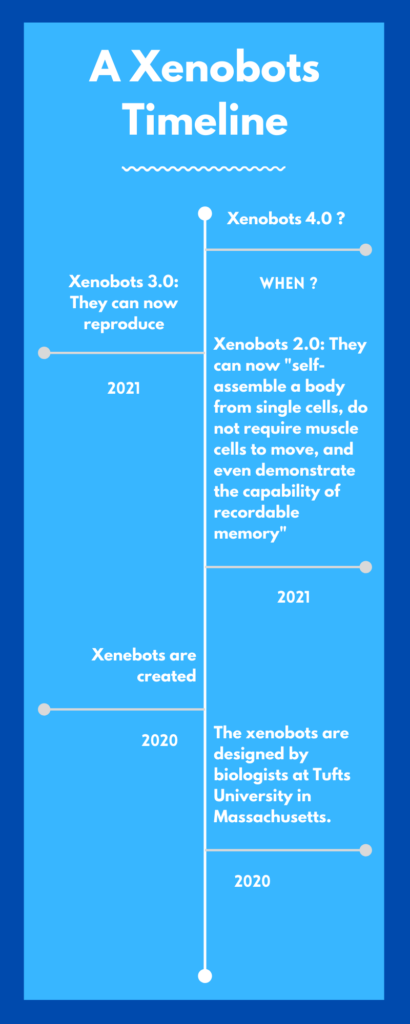Earlier, in December 2021, the world was introduced to the Xenobots 3.0. To fully understand what Xenobots are, it is important to travel back in time to 2020, when this technology was still a theory.
The Birth of Xenobots
In 2020, the Xenobots were designed by biologists at Tufts University in Massachusetts and were then created the same year. Xenobots is the name that was given to them, as their design was inspired by the African clawed frog: “Xenopus laevis”. The main goal at the time was to reproduce the lifeforms through synthetic molecules. Since then, one question remains among the scientific community: should Xenobots be recognized as an organism? A robot? Or something totally new that doesn’t exist yet?
The story about their conception is worth reading, as the blueprints were designed by AI. Douglas Blackiston and Sam Kriegman were the key players concerning its development. Kriegman was responsible for the AI blueprint generator, while Blackiston was responsible for assembling the pieces together.
It is important to note that these “bots” aren’t as big as you could imagine. Their size is less than 1 millimeter wide, making them invisible to the human eye. The recipe for such a technology is made from two ingredients: skin cells and heart muscle cells. The skin cells are in charge of holding up the whole structure, and the heart muscle cells are accountable for their “life”. Ultimately, Tufts University biologists have designed the original Xenobots to be able to move and cooperate.
In spring 2021, Xenobots 2.0 were introduced to the world. The technology had received major upgrades. First, they have the capacity to self-assemble independently from muscle cells. Furthermore, the second version proved to have the potential of what is known as “recordable memory”. Memory recordings are defined as: “a permanent record of your thoughts, feelings, and memories” (lifenaut.com). Essentially, this means that reinforcement learning would be possible, as they would recall their past experiences.
In December 2021, Xenobots experienced a breakthrough with the emergence of their newest version: Xenobots 3.0. The technology was now able to self-replicate. The goal of working together to survive was now reached, as the synthetic molecules are also able to work together to heal themselves once damaged. This last upgrade raised many topic discussions as to how this could come into play to benefit the world.
Revolutionary Potential
Josh Bongard, computer scientist, and robotic expert believes that the Xenobots need to be given tasks that are more useful. He says: “We want Xenobots to do useful work. Right now, we’re giving them simple tasks, but ultimately, we’re aiming for a new kind of living tool that could, for example, clean up microplastics in the ocean or contaminants in soil”.
As one of the masterminds behind this work has said himself, Xenobots could come into play against the environmental crisis. Imagine for instance, if a version of the technology was able to absorb the CO2 particles? If it could reinforce and help strengthen the ozone layer? Or maybe it could clean polluted waters by disintegrating waste in the water. This could be one of the solutions, plus we wouldn’t even need to worry about Xenobots polluting water because as Douglas Blackinston specifies: “the Xenobots eventually break apart and are totally biodegradable”.
Another promising potential that Xenobots have, is within the healthcare sector. Many scientists hope that the technology will be used for biomedical needs. Josh Bongard believes that their swarm intelligence capacity will play a major role in this industry. According to sciencedirect.com, “Swarm intelligence (SI) is in the field of artificial intelligence (AI) and is based on the collective behavior of elements in decentralized and self-organized systems”. This technology means that in medical fields such as vaccinations, Xenobots could be inserted within the human body to counter diseases. Think about Covid-19 today, you could potentially cure the disease with a “bot” that would learn to adapt and fight against it. This “bot” could therefore be injected inside the human body and become a solution to the pandemic.
With so much potential, so much to offer, one can only ask, what could possibly go wrong?

Lethal Drawbacks
Here is an extract from the United Nations’ Biological Weapons Convention and the 1925 Geneva Protocol and Chemical Weapons Convention: “Any hostile use of Xenobots, or the use of AI to design DNA sequences that would give rise to deliberately dangerous synthetic organisms, is banned”. With the rise of such a technology, the United Nations have already taken a position against its potentially destructive side.
Xenobots, as well as they can be used for good, can also be used for immoral practices. If we take the example of an individual who wants to cause mass destruction, he could use Xenobots and make them a lethal weapon for the human species. Let’s say he taught the synthetic molecule to fight against the humans’ immune system and create a disease that can spread easily and kill you in a matter of seconds. This could potentially be a scenario where humans could go extinct.
However, according to Kriegman, his invention is “an extremely controllable and stoppable and safe system”. As this might be the case today, only one could know how such a technology could evolve in harmful ways, especially if instructions on how to conceive Xenobots were to be leaked.
Should it be legal?
This is a question that can be answered ethically, but also on the health security scale. A good comparison is human cloning. In 2005, the United Nations declared that they would be prohibiting “all forms of human cloning inasmuch as they are incompatible with human dignity and the protection of human life”. As the potential for such innovations seems groundbreaking, its dangers could also become out of control. Technological progress, in general, is extremely volatile, which means that its unpredictability could escalate into terrible conditions for human beings.
Such a dilemma can be found in any technology nowadays. There is this sudden urge to develop as fast as possible, without taking into consideration the possible constraints. The underlying fact is that banning technology is a secure way not to be harmed by it, but is also a way not to benefit from it. For example, banning cloning has proved to work regarding human-clone danger, yet other problems are threatening human life. The major one is the environmental crisis.
As a reminder, “There will be no water by 2040 if we keep doing what we’re doing today”, according to Professor Benjamin Sovacool from Aarhus University in Denmark. This means that we have 18 years to find a solution to counter the effects of the growing pollution. By consistently banning technology, we are closing the doors to solutions that could maybe solve the environmental crisis.
The proper answer is to regulate, or maybe restrict the use of Xenobots to all private companies, so that it is possible to focus and manage the development of such a technology, to prevent it from becoming a deviant mean. As such, the government should theoretically ensure that the innovation is used in beneficial ways.
Sources used:
https://www.fox10phoenix.com/news/xenobots-worlds-first-living-robots-can-reproduce-scientists-say
https://www.sciencedirect.com/topics/engineering/swarm-intelligence
https://www.the-scientist.com/news-opinion/xenobot-living-robots-can-reproduce-69477

